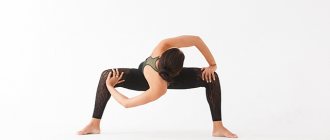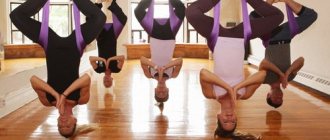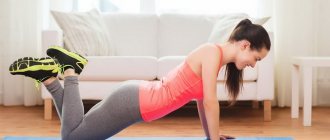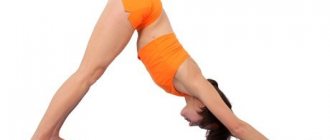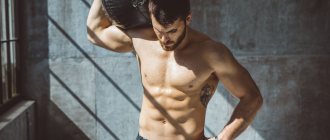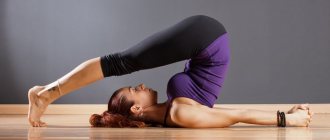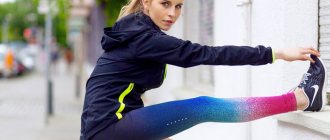The main differences between yoga and Pilates
Pilates and yoga are health systems that include exercises to develop flexibility, endurance, and concentration. Regular exercise puts your body in order and allows you to find harmony with yourself. In this both areas of fitness are similar. To understand how yoga differs from Pilates, let's look at their features.
Features of yoga
Yoga is an ancient Indian system of human self-development, which originated long ago in our era. This is a spiritual tradition, the experience and wisdom of many generations, which millions of people around the world follow to this day.
Translated from Sanskrit, yoga means “union, connection, harmony.” Those. unity of a person’s physical and mental state, harmony of health and spiritual beauty. The purpose of the classes is to achieve and maintain this unity.
It is impossible to imagine yoga without performing various asanas (static poses) that help improve the body. But physical practice is only part of the philosophy of yoga, one of the tools for working on consciousness. It also includes:
- rules of personal and public behavior;
- breathing exercises;
- meditation;
- chanting mantras;
- cleansing the body;
- concentration;
- desire for complete control over the senses.
Therefore, yoga is a way of life aimed at achieving a balance of physical and psychological health, and not just a set of static exercises that develop flexibility and endurance.
Yoga classes include not only asanas, but also breathing practices, meditation, and chanting mantras.
Over the long history of the development of yoga, several different directions have appeared in it. In the West, the most popular is hatha yoga, which, in turn, also has many styles:
- Ashtanga Vinyasa;
- Iyengar yoga;
- Sivananda;
- Kundalini;
- Kriya yoga, etc.
Each movement has its own characteristics, methods and tools for self-improvement. For example, Ashtanga Vinyasa is a dynamic type of yoga; Iyengar practices use auxiliary objects when performing asanas; Kriya yoga is based on meditation, breathing exercises, and chanting mantras. But the essence of all hatha yoga movements is common - to achieve harmony of body and spirit, to experience the joy of complete health.
A special feature of yoga classes is conscious breathing through the nose (both inhalation and exhalation). Masters of the ancient practice consider breathing through the mouth to be as unnatural as eating through the nose.
Features and basic principles of Pilates
Pilates is a system of healing the body, based on dynamic exercises that are performed in a certain technique and sequence. Their goal is to develop flexibility, improve the condition of the joints and spine, posture and coordination of movements.
Pilates, unlike yoga, is a young trend in fitness. German trainer Joseph Pilates developed gymnastic exercises for the rehabilitation of patients suffering from diseases of the musculoskeletal system at the beginning of the 20th century.
Basic principles of Pilates
- Constant control over the muscles of the “center” - a group of deep muscle layers of the abs, back, and pelvic floor. They must be on their toes all the time.
- Smooth and uniform movements. Each exercise is performed at a certain pace and rhythm, without jerking or haste.
- Concentration of attention. It is not the number of exercise repetitions performed that is important, but their quality. The principle “Die, but get in perfect shape” does not work here. Concentrating on the work of a specific muscle helps you feel the tension, getting the maximum effect from the exercise.
- Breathing control: take a deep breath in deeply through the nose, exhale through the mouth while simultaneously pulling the stomach towards the spine.
The point of the Pilates method is to learn to control muscle function and gracefully perform natural movements. Thoughtful, leisurely training teaches you to use your body with maximum efficiency in everyday life. The goal of a successful exercise is movement without overexertion: an equal amount of energy is allocated to relaxation for the efforts made.
6 fundamental differences
Thus, 6 fundamental differences can be distinguished between Pilates and yoga.
- Yoga is an ancient system of self-development, philosophy, and way of life. Pilates is a relatively young health system for the body, one of the types of fitness.
- Pilates training is aimed at creating a healthy body, yoga practice is aimed at achieving harmony of body, spirit and mind.
- Many exercises and asanas are similar, but have significant differences in execution technique. If in classical yoga you need to enter a pose and hold it for a long time (static load), then in Pilates the main thing is movement. All exercises are dynamic and repeated several times. Consistent articulation of the spine and body muscles when entering and exiting a position is important.
- Breathing control in Pilates helps you concentrate on the exercise and the muscles working. The ancient practice involves breathing as one of the steps to self-improvement (pranayama).
- Pilates mainly works the back and core muscles, while yoga works all muscle groups.
- In classical hatha yoga, no additional equipment is used, only a mat is needed. In Pilates classes, elastic bands, fitballs, rings, and rollers are actively used.
There is some difference between them in the effect they have on the body and contraindications for exercise. This will be discussed below.
LiveInternetLiveInternet
A set of exercises developed almost a century ago by the German doctor and athlete Joseph Pilates is today perhaps one of the most popular training systems in the world.
It combines a Western approach and Eastern elements of a conscious attitude towards movement.
A minimum of tedious repetitions in the process, stretching, flexibility and endurance in the end.
The basic exercises of the Pilates system are demonstrated by the instructor of the Extreme Fitness fitness club Svetlana Kozlova. All exercises should be performed slowly and smoothly, repeated 5-10 times. Having reached a vertical position of the back, we continue stretching with a twist: as we inhale, we “grow” upward, and as we exhale, we rotate the body. Repeat in both directions.[/td]
| Spinal stretch. Starting position: standing, shoulders relaxed, slightly stooped. Smoothly lower your head and neck - vertebra by vertebra, then bend in the thoracic region. | Then we relax the lower back and sacrum. The neck is relaxed, the head is lowered. After this, we perform the exercise in reverse order. |
| Roll-up (rolling up). From the starting position (lying on the floor with extension), slowly, rounding your back, raise your arms, head, and shoulders. | |
| As you exhale, we lie down and stretch along three lines: arms, legs, spine behind the crown. | After this, return to the starting position - smoothly, without jerking, rounding your back and “laying” the vertebrae one by one on the floor. |
| Rollover (twisting behind the head). Starting position: lying on your back, arms along the body, legs perpendicular to the floor, extended. | As we exhale, we lower our extended legs until we can keep our lower back pressed to the floor. |
| Without stopping the stretch, we point our feet towards ourselves. Breathing chest. | After this, we stretch the spine back, lifting the pelvis from the floor. At the same time, you should not lift your head or strain your neck. |
| Ab exercise “Hundred”. From the starting position (lying on your back, legs at an angle of 45°), slowly raise your upper back and stretch your arms forward. At the same time, we do not lift the lower back off the floor, the stomach is pulled in. | As we exhale, we move our arms back, hold for a second, and exhale. While inhaling, return to the starting position. |
| Swing your leg (execute slowly!). Starting position: kneeling, feet together. | Slowly we lower ourselves to the side. The palm of the left hand is located strictly under the left shoulder, the right leg is parallel to the floor. The elbow of the right hand points to the ceiling. |
| We perform a swing: the extended leg goes forward with the toe. When swinging back, use your heel. | After this, we lower our right leg and stretch it, our right arm stretches up and to the side. |
| "Swimming". Starting position: lying on your stomach face down, feet and hands shoulder-width apart. | Alternately raise the opposite arm and leg up. Perform 10 times in three passes. |
| Stretching: Dolphin exercise. Standing on your feet and hands, we form a right angle with the floor, your feet are on your toes, your arms are extended. We reach with the top of our head towards the floor without touching it. | We transfer our body weight to our arms, strongly arching our back, and hold this position for some time. |
Source
Similarities between Yoga and Pilates
Unlike most types of fitness, yoga and Pilates classes are not aimed at losing weight, but primarily at improving the health of the body. A slim figure becomes a “side” effect of long and hard training. In this both systems are very similar. Their main goal is to learn to listen and control their body.
Yoga, like Pilates, has a beneficial effect on all body systems. Exercises develop flexibility, coordination of movements, and improve posture. Regular exercise helps get rid of psychological pressures and stress.
The systems are similar in other criteria:
- during classes, attention is focused on breathing, internal strength, and the correctness of the exercise is monitored;
- you can exercise both in a sports club and at home;
- a lot of stretching, flexibility, muscle relaxation exercises;
- training takes place at a smooth pace, there are no jumping, running, or sudden movements.
Yoga and Pilates are ideal for those who want to gain health, get rid of chronic diseases, and find harmony of soul and body. You can start training at any level of physical fitness, at any age.
The main differences between stretching and Pilates
Two modern trends in fitness - stretching and Pilates - help to achieve a graceful and slender figure with a flexible spine and ballet-like muscles. But they have a different history of origin and are built on different sets of physical exercises and principles. To understand the differences between stretching and Pilates, let's look at the features of each direction.
Features of Pilates
Pilates is a health-improving exercise system developed in the 1920s by German trainer Joseph Pilates for the rehabilitation of wounded soldiers and camp prisoners. It is aimed at improving the condition of the spine and joints.
The focus is on developing the core and abdominal muscles (called “core muscles” in Pilates), as well as stretching the spine.
Regular exercises can improve posture, coordination of movements, restore the physiologically correct curve of the spine and eliminate muscle tension.
Basic principles:
- all exercises of the complex are connected in one chain and are performed in a certain sequence;
- movements are smooth, without jerking;
- attention is concentrated on correct breathing and body position;
- constant tension of the muscles of the center - the abdominal muscles, pelvic floor and back.
Pilates is a dynamic type of physical activity, but the goal is not to perform as many repetitions as possible in a certain time - it is more important to do the exercises correctly, to feel the tension and work of the muscles as much as possible.
Features of stretching
The word stretching comes from the English. stretching - stretching. This is a set of exercises that develop body flexibility, joint mobility and ligaments. This trend of fitness does not have a creator or an exact date of birth. Swedish scientists first talked about the health benefits of stretching in the 50s of the 20th century, but it was known back in the days of Roman gladiators and ancient Greek Olympic athletes.
Stretching is based on alternating muscle tension and relaxation. Stretching exercises allow you to develop the flexibility of absolutely all muscles of the body and achieve mobility of all joints.
Basic principles:
- hold the muscle in a stretched position for 15-30 seconds, gradually increasing the time to one minute;
- Perform all movements smoothly; there should be no pain during exercise;
- increase loads gradually - the frequency, amplitude and intensity of movements increases from lesson to lesson;
- perform stretching exercises after a mandatory warm-up, which will increase the temperature of muscle tissue and prevent injury;
- training should be regular and systematic (at least 4-5 times a week).
Stretching is mainly a static type of physical activity (the exception is dynamic stretching, when springy movements are performed with full amplitude). In each lesson you need to strive for progress - to stretch a little more than last time.
Differences
Thus, a number of fundamental differences can be distinguished between the two types of fitness:
- Most of the exercises in Pilates are dynamic, while in stretching they are static;
- the main goal of Pilates is to correct spinal disorders, stretching is to increase flexibility and mobility of joints;
- when stretching, you do not need to focus on the “centre muscles”, as in Pilates, and control your breathing - the main thing is not to hold it while stretching the muscle;
- the Joseph Pilates system is based on a clear sequence of exercises, while greater freedom of movement is allowed in stretching;
- the emphasis in Pilates is on working the muscles of the core, abdominals and back; stretching involves all the muscles of the body;
- you can do stretching after cardio or strength training, use stretching exercises as a cool-down, Pilates is a full-fledged 40-60 minute training program (although some exercises can be used when doing other types of fitness, for example, planking);
- To progress and achieve goals, you need to stretch your muscles daily or 4-5 times a week; Pilates is enough to do every other day.
In stretching, unlike Pilates training, the help of a partner is often used to work out tight muscles that are difficult to stretch on your own. In addition, there are several types of stretching, which are based on different methods of tensing and relaxing muscles.
The benefits of these types of fitness
Regular classes of both yoga and Pilates have a powerful healing effect on the body: they tidy up the functioning of internal organs, joints and muscles.
The benefit lies in several aspects:
- increases flexibility, mobility and strength of joints;
- posture and condition of the spinal column improves;
- pain in the neck and back disappears;
- general well-being improves;
- immunity increases;
- hormonal levels are normalized;
- sexual health improves;
- performance increases.
Yoga also has a positive effect on mental health:
- allow you to achieve spiritual peace;
- learn to manage your emotions;
- help you gain a sense of confidence in yourself and the world around you.
Indian practice is often used to treat depression, mental disorders, and persistent insomnia. Read more about the benefits of yoga in this article.
Pilates brings the condition of the spine to a physiological norm, eliminates tension, and rebuilds the functioning of the muscles that support it. Thanks to this “restructuring,” the condition of the entire organism as a whole improves. The benefits of yoga are more multifaceted - systematic practice leads to a balance of physical and psychological health.
Contraindications
Despite the fact that yoga is designed to improve well-being and improve health, not everyone can practice it. You cannot exercise when:
- infectious lesions of the brain or spinal cord;
- malignant neoplasms in the body;
- severe pathologies of the heart and blood vessels;
- increased intracranial pressure;
- arterial hypertension 2-3 degrees;
- infectious arthritis;
- schizophrenia.
Exacerbations of any chronic diseases are also contraindications to yoga practice.
Pilates can be practiced in any condition of the body. The only exceptions are acute periods of infectious diseases (fever), bone fractures, and exacerbation of a spinal hernia. You cannot exercise after surgery for at least six months.
What's best for losing weight?
You won't be able to lose weight quickly using the Joseph Pilates method. The exercises are performed at a slow pace, there is no cardio or strength training that would contribute to weight loss. In an hour of training you can burn a maximum of 200 kcal.
Unlike Pilates, during ancient Indian practice classes the muscles are in static tension, which increases calorie consumption to 300-350 and promotes weight loss.
Holding the body in asanas engages slow muscle fibers, which activate the process of burning fat deposits. These muscles cannot be used during dynamic repetition of movements.
This type of yoga, such as Power Yoga, helps you lose weight even faster - the static load on the muscles in asanas is supplemented by cardio and strength training, the number of calories burned per hour increases to 400-500.
Yoga and Pilates are more suitable for maintaining good physical shape after losing weight. Regular exercise combined with proper nutrition and an active lifestyle will prevent you from gaining excess weight and will help keep your body in good shape.
Who might be interested in stretching?
To fully experience the benefits of stretching, the degree of enthusiasm for physical exercise is not important. Improving blood circulation is equally beneficial at any age, and joint mobility prevents the development of a number of serious diseases. Good physical shape is a barrier to aging of the body, which gradually begins after 25 years.
Stretching to strengthen the spine, static exercises, somewhat similar to yoga, will appeal to those who want to become flexible. Muscles are stretched and joint mobility increases. With the help of a trainer, you can achieve amazing results during paired exercises. But don’t confuse stretching, even in difficult poses, with yoga. The latter direction is associated with broader boundaries and pursues not only the strengthening of physical fitness, but spiritual philosophy.
What's better for your back?
The Joseph Pilates system was specially designed for the rehabilitation of patients with spinal diseases (osteochondrosis, hernias, posture disorders) and previous back injuries. A set of exercises strengthens the muscular corset that supports the spine and normalizes its functioning. Gradually it returns to the physiologically correct position, blood circulation is established in the intervertebral discs, and compressed nerve endings are released. It is difficult to find a more useful form of fitness for the back than Pilates.
Yoga classes, of course, also have a positive effect on the condition of the spinal column:
- improve posture;
- strengthen the muscular corset of the back;
- relieves tension on the nerve endings of the spine.
But the result will become noticeable a little later than with Pilates - it takes more time to strengthen the muscles and develop the flexibility of the spinal column.
If you have problems with your spine, you should consult your doctor and trainer before practicing Pilates or yoga. He will create an individual set of exercises in accordance with the nature and location of back pain.
What do you need to know when starting training?
Nutrition
You should not eat before training, as this can lead to heartburn. Milk, cottage cheese or a small portion of porridge is acceptable no more than 30 minutes before the start of the workout. Afterwards, you can start eating after 1-1.5 hours, excluding foods that contain caffeine.
Breath
As you prepare to perform the movement, inhale. Then, as you exhale, pull your stomach towards your spine and make the necessary movement. Repeat the deep breath, relax and return the body to the starting position. It will take time to develop the correct breathing technique; it must be monitored throughout the entire workout, since it is this factor that allows you to mobilize the muscles and increases the effectiveness of the workout.
Schedule
Doctors and professional trainers recommend training 3 times a week for 1 hour. Cardio training is an excellent addition to Pilates, so running or cycling will help diversify your regular workout. When performing Pilates exercises, the emphasis is not on quantity and duration, but on the quality of the training performed. Organize your time taking into account your individual characteristics and preferences. It is recommended to start with small training sets of 15-20 minutes to learn concentration, breathing and proper exercise technique.
System
You can start training from any position, but under no circumstances jump sharply from one to another. Distribute your exercises logically, for example, after doing arm exercises, move on to the next higher area and then distribute the load evenly to each part of the body.
Clothing and equipment
For training, choose clothes that will not restrict your movements. At the same time, it should not be too loose and voluminous, since at first you definitely need to monitor the correct execution of the exercises. The classical Pilates technique involves performing exercises without shoes. The following equipment can be used: rollerball, fitoball, miniball, elastic band, core board, step roller and much more. For basic exercises, a regular mat will be enough.
Can I do yoga or Pilates on my own?
Both systems are suitable for practicing at home - no special equipment is needed, and the exercises can be easily mastered using video lessons for beginners or specialized literature.
However, before self-training, it is advisable to consult an experienced trainer who could clearly convey the key principles of yoga or Pilates and show how to perform the exercises correctly.
Incorrect technique for performing exercises and asanas during independent training can cause the opposite effect. Sometimes in poses and exercises the wrong muscles are tensed that are actually supposed to work. Relearning is always more difficult than learning to do it right from the very beginning.
Yogalates training
The Yogalates training plan includes about 40 points, but their number varies depending on the time of training. Most of the points are based on yoga. At the beginning, they master warm-up exercises (20-minute stretching exercises).
In another part, the trainer conducts a course on traditional yoga positions. Each exercise contains Pilates elements, and the time to perform classical positions is extended, and the practitioner must stay in it longer. Then there are typical Pilates exercises to train the abdominal muscles. People who deal with this technique should notice the difference.
Yoga for beginners or exercises with Pilates and yoga may seem quite difficult, since a person does not know all the figures. But this is not the main thing, you must not only remember them and learn to perform them mechanically, the correct mental attitude and knowledge of the philosophy of teaching are very important. Teachers and instructors pay attention to the structure of the body, its movements, and also teach proper breathing.
What is easier for a beginner to master?
For beginners in fitness, it will be easier to master the Joseph Pilates set of exercises. The training does not require high initial physical fitness and is suitable even for those recovering from serious illnesses. All exercises are performed at a slow pace, to the extent of preparedness and health. All of them are safe and low-traumatic.
To practice yoga, experience in fitness or sports is desirable - performing asanas requires significant muscle strength and endurance. In addition, some poses are so intricate that it is impossible to do without flexible joints and trained muscles.
In any case, both systems provide classes for beginners that will help you gradually integrate into the training process without injury or stress to the body.
Definition and similarities
Pilates and yoga are practices that are used to heal and strengthen the human body. They exclude power loads, intense tempo, and the performance of “extraordinary” techniques and are suitable for people with any level of physical fitness. In addition, beginners are not recommended to do either practice on their own. It is still better to conduct the first lessons under the guidance of an experienced trainer, who will point out shortcomings and correct the execution of movements.
These few points bring together practices that are indeed very similar. Otherwise, their differences are so colossal that novice athletes should definitely learn about them.
For example, Pilates is a unique system that was developed by Joseph Pilates to increase the physical capabilities of the body in order to overcome various diseases. Having suffered from many pathologies since childhood, he, like no one else, understood what needed to be done to get a good result.
Pilates is ideal for those who want to improve not only their figure, but also improve their health. It is based on the combination of seven specific principles (regularity, concentration, clear sequence, good stretching, endurance, proper breathing, statics), which can be mastered after just a few lessons.
At the same time, yoga is an ancient system of practices that was developed over a long period of time by those who chose the path of enlightenment and improvement. Being a universal technique by its nature, it teaches practitioners to understand themselves through physical exercises with synchronized breathing. People who study the system for a long time are able to control their consciousness, well-being and live in harmony with the world around them.
Therefore, in order to choose between these two directions, you should first decide what exactly you want to get as a result.
New direction - yogalates
Relatively recently, a new trend in fitness has emerged - yogalates. The training program combines elements of ancient oriental practice and Pilates. The most effective exercises from both health systems alternate with breathing techniques. Here, just as in yoga, a positive attitude and awareness are important, as in Pilates - concentration and “search for the center.”
A set of Yogalates exercises helps you achieve a beautiful body and good health in a fairly short period of time. But still, it is more of a physical education nature, and will not help you feel all the effects of yoga.
This direction is suitable for those who are bored with regular Pilates or yoga classes, and the spiritual component of Eastern practice is not as important as a good figure and well-being.
So which is better to choose?
Yoga and Pilates in their original form are two completely different methods: philosophy versus the method of control and management of the body (Joseph Pilates himself called it controlology). But today, having evolved, both systems seem very similar. In addition, within each of them there are many movements, styles and schools with different approaches and ways of achieving results, so some of the differences between yoga and Pilates are blurred.
If we talk about the classical schools of these two health systems, the difference between them is still significant. All similarities and differences can be summarized in a table.
| Criterion | Pilates | Yoga |
| Time of occurrence | Early 20th century | 3rd century BC |
| primary goal | Strengthen back muscles, improve posture, stretching, gain control over the body | Achieve harmony with yourself, feel the joy of physical and spiritual health |
| Tools for achieving goals | Exercise, proper breathing | Asanas, meditation, breathing exercises, rules of behavior in society, various rituals, chanting mantras |
| Who is it suitable for? | People with injuries, diseases of the musculoskeletal system, beginners in fitness | Those who want to get rid of chronic diseases, mental stress, maintain health for many years, achieve perfection |
| Breathing technique | Constant control of breathing: inhale through the nose, exhale through the mouth | Breathing through the nose using various breathing exercises |
| Load nature | Dynamic | Static |
| Best time to practice | Evening | Morning |
| Necessary equipment | A rug or mat, you may need a fitball, elastic bands, bolsters | Rug |
| Do I need an instructor? | Possibility of self-teaching the basics | It is advisable to have the supervision of a master at least at the initial stage. |
| Results from training | Improved posture and general health, increased endurance | Achieving harmony of body and spirit, improving well-being |
If you want to get a little more than just a beautiful and healthy body, then you should opt for yoga. After all, the ancient practice is also aimed at working with the mind and includes methods of spiritual development and self-improvement. You can try both systems or Yogalates. Practice will show what suits you.
The essence of directions
Both practices - yoga and Pilates - have a common goal: to strengthen and heal the human body. During training, the body is not subjected to extreme force loads, there are no complex exercises at an intense pace. Thanks to this, almost everyone will be able to master the technique. But in order to choose which direction is suitable for a particular beginner, you need to understand their essence, as well as identify similarities and differences.
Yoga is a practice that was formed in ancient times. It develops not only the body, the soul also goes through the path of improvement. Yogis constantly learn about their abilities, learn to synchronize breathing with movements, and tune in to correct thinking. The main goal is to gain the ability to control consciousness, thoughts and feelings and thereby achieve complete harmony both with oneself and with the world.
Pilates as a fitness trend was formed quite recently - in the last century. The author of the technique, after whom it was named, created it to increase the physical capabilities of the human body and treat many diseases. Pilates is aimed mainly at improving the health of the body through regular exercise, stretching, endurance training, proper breathing and maximum concentration.

